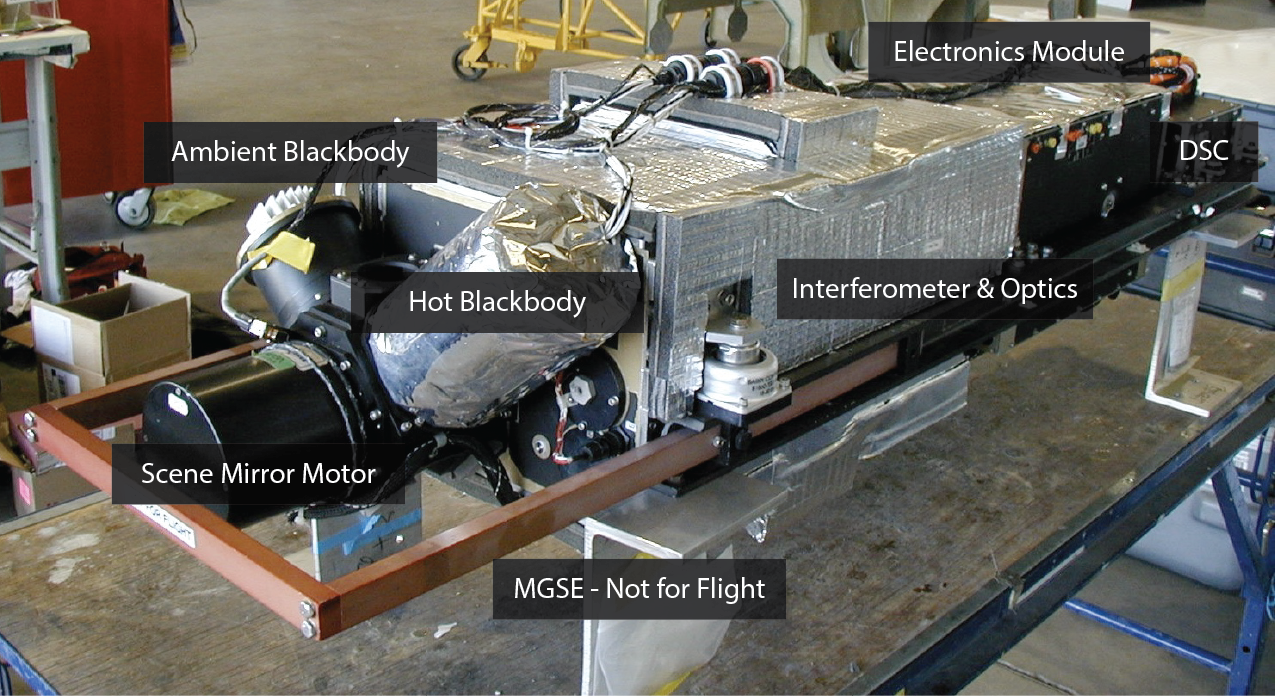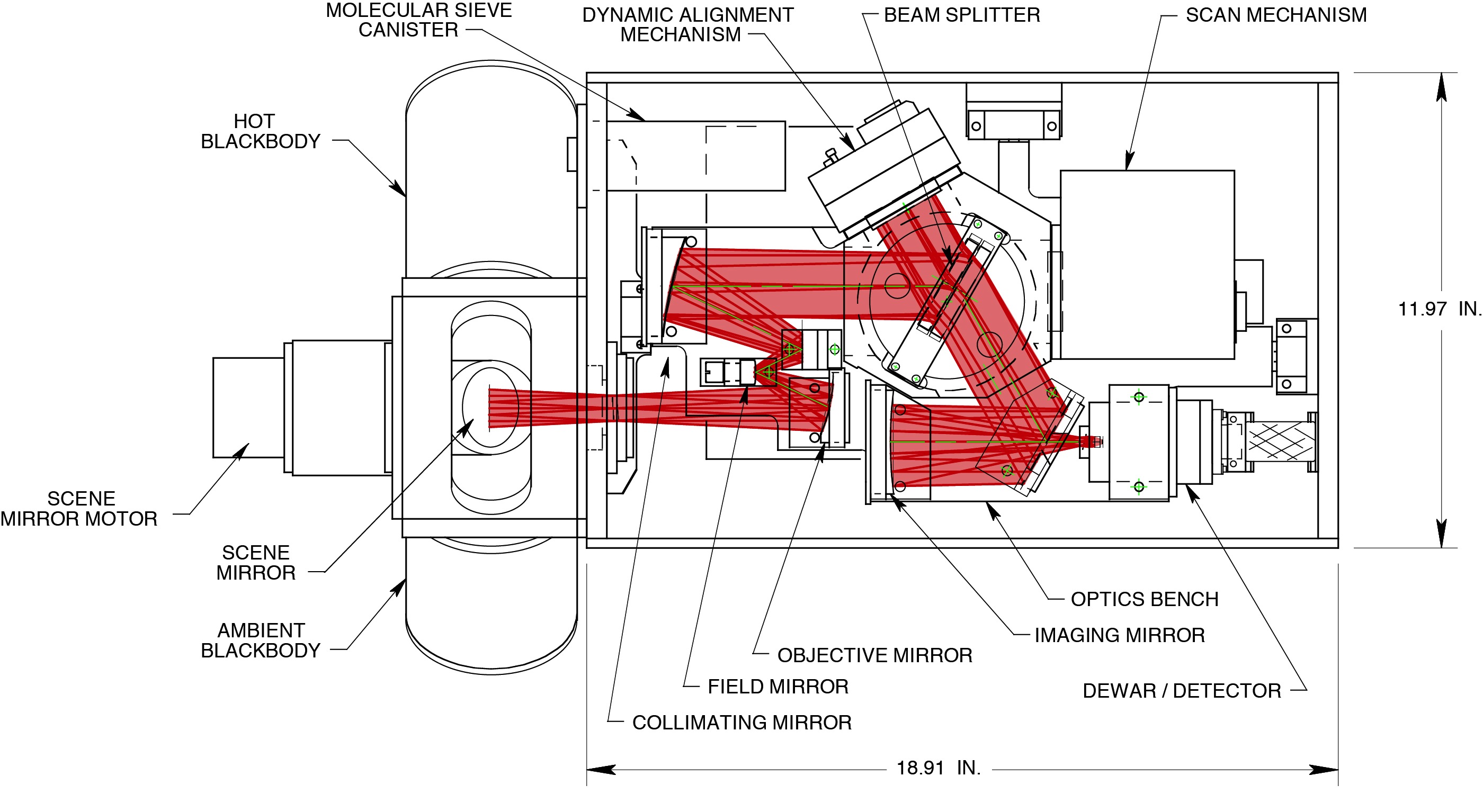Overview
The Scanning High-resolution Interferometer Sounder (S-HIS) is a cross-track scanning interferometer sounder which measures emitted thermal radiation at high spectral resolution between 3.3 and 18 microns. The measured spectrally resolved radiance is used for a variety of applications, including retrieval of temperature and water vapor profiles of the Earth's atmosphere, determination of surface emissivity and temperature, and validation of radiative transfer models and satellite measurements. The S-HIS produces sounding data with 2 kilometer spatial resolution (at nadir) across a 40 kilometer ground swath from an altitude of 20 kilometers (0.100 mrad FOV). The S-HIS instrument flies on a number of airborne platforms including the NASA ER-2, DC-8, Proteus, WB-57, and Global Hawk. On the Proteus and WB-57 aircraft, a zenith view is available, providing a means for calibration verification and studies of upper level water vapor.
The S-HIS is an advanced version of the HIS NASA ER-2 instrument. The S-HIS was initially designed to fly on an unmanned aircraft vehicle (UAV) with limited payload capacity. This drove it to be small, lightweight, and modular, with low power consumption. It was developed between 1996 and 1998 at the University of Wisconsin (UW) Space Science and Engineering Center (SSEC) with the combined support of the US DOE, NASA, and the NPOESS Integrated Program Office. Its design and calibration techniques have matured from experience with the HIS and with the ground based Atmospheric Emitted Radiance Interferometer (AERI) instruments developed for the DOE Atmospheric Radiation Measurement (ARM) program. The nadir-only spatial sampling of the original HIS has been replaced by programmable cross-track coverage with similar sized footprints. The S-HIS is also smaller, more robust, and easier to operate. Since 1998, the S-HIS has flown in several field campaigns and has proven to be extremely dependable and effective.
The S-HIS instrument is maintained and operated by the Space Science and Engineering Center at the University of Wisconsin-Madison in Madison, WI. The principal scientific investigator for the S-HIS is Dr. Joe K Taylor.

The Scanning High-resolution Interferometer Scanner (S-HIS); Proteus integration, Scaled Composites, July 2004.
Flight Calibration Assembly
The flight calibration assembly consists of a 45° scene mirror, two calibration sources, the scene mirror motor, and front-end hex structure. The S-HIS 45° scene mirror allows the instrument to image using cross-track scanning. It executes a sequence consisting of multiple views of the earth, a zenith view (when available), and the two calibration sources, one at ambient and another controlled to a fixed temperature (typically 305 K in flight). The S-HIS calibration techniques achieve the high radiometric accuracy needed for atmospheric state retrieval, spectroscopic applications and calibration validation activities.
Interferometer Module
The S-HIS employs a customized commercial dynamically aligned plane-mirror interferometer (DA5 from Bomem Inc, Quebec, Canada). The Michelson mirror is voice coil driven with a support mechanism that was designed and built at UW-SSEC to make use of a linear bearing approach to minimize vibration-induced tilt errors. The spectral characteristics of the measurements are very well known and stable because of the use of a HeNe laser to control optical delay sampling. A 1/4-wave quadrature system is used to assure that no samples are dropped or miscounted. The laser is also used to maintain alignment via the dynamic alignment (DA) servo. Any residual misalignments are measured as a diagnostic and as the basis for corrections as needed.

Diagram of the S-HIS interferometer module and flight calibrator assembly viewed from the nadir perspective. The Zemax prescribed IR beams are shown, and have been omitted from the figure between the beamsplitter and the Michelson mirror. The interferometer enclosure is not pressurized and instead is based on a ‘breathing’ design. Incoming air enters the enclosure via a one-way valve at the base of the molecular sieve canister assembly.
To achieve the required noise performance, the spectral coverage is divided into three bands with separate detectors for each band (two photoconductive HgCdTe and one InSb). Together, the three detector bands provide continuous spectral coverage from 3.3 to 16.7 μm at 0.5 cm-1 resolution, with overlap between the adjacent bands that is useful for instrument diagnostics. Due to the initial design constraints on size, the S-HIS instrument uses a novel detector configuration with the shortwave detector positioned in front of the side-by-side longwave and midwave detectors that share the available aperture. The bands use a common field stop, ensuring accurate spatial co-alignment. This arrangement allows cooling to be provided by a single mechanical cooler and eliminates the need for dichroic beamsplitters. The cooler is a 0.6 W, split-cycle Stirling cooler from Litton.
Electronics Module
The electronics module provides all the electrical support functions for the instrument, including the power conversion and distribution, interferometer control, the instrument science and control digital signal processors (DSP), as well as scene mirror, blackbody, and heater control. The Science DSP compresses the raw interferograms for each scan in real-time using a numerical filter and decimation algorithm. The Control DSP is responsible for instrument control.
Data Storage Computer
The original S-HIS data storage computer (DSC) was an environmentally hardened laptop enclosed in a pressurized enclosure. This concept resulted in an overly massive design that needed additional vibration isolation to operate. The current data storage computer is based on an industrial single board computer (EBX form factor, low-power fanless Celeron 566 MHz processor) with a PC-104+ bus for expansion cards. The design requires no enclosure pressurization and uses a solid-state drive (SSD) for data storage. The unit has operated effectively and dependently on the ER-2, the Proteus, the WB-57, and the Global Hawk.
S-HIS Flight Experience
From 1998 to present, the S-HIS has been involved in 28 field experiments on five different airborne platforms. The measurement applications have included radiances for radiative transfer models, temperature and water vapor retrievals, cloud radiative properties, cloud top retrievals, surface emissivity and temperature, trace gas retrievals, and satellite calibration validation. See the Experiments page for details.
Sponsors and Partners
The S-HIS instrument was developed jointly with Bomem, Inc. Support for S-HIS development has been provided by the Department of Energy, NASA, and the Integrated Project Office (IPO).


